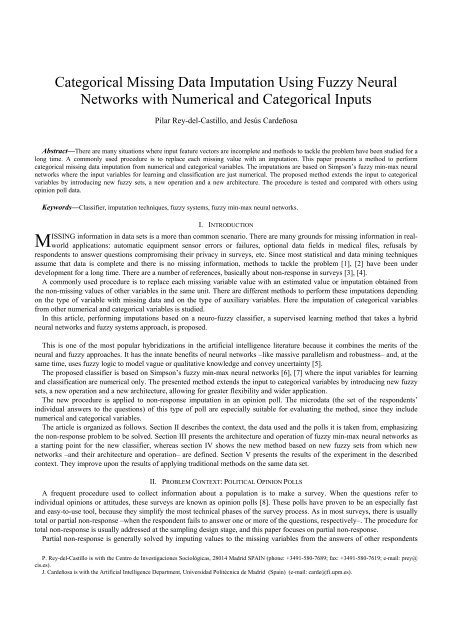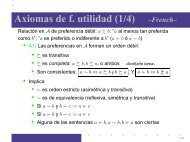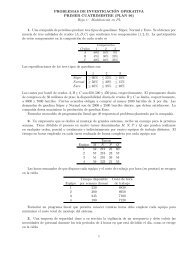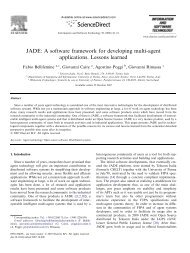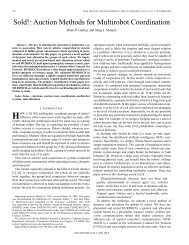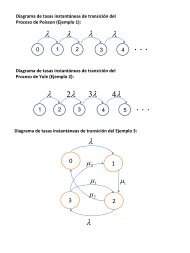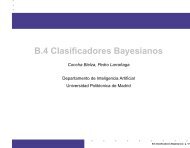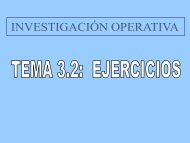Categorical Missing Data Imputation Using Fuzzy Neural Networks ...
Categorical Missing Data Imputation Using Fuzzy Neural Networks ...
Categorical Missing Data Imputation Using Fuzzy Neural Networks ...
- No tags were found...
Create successful ePaper yourself
Turn your PDF publications into a flip-book with our unique Google optimized e-Paper software.
dimension, min-max networks only use values that range from 0 to 1.nThus, the input space is the n-dimensional unit cube I = [ 0 ,1] × [ 0,1] × K × [ 0,1]ordered set. The hyperbox fuzzy set B j is defined by theBjn{ x,v , w , b ( x,v , w )} ∀ x∈I= ,where v = ( v , , v ) is the hyperbox minimum, w = ( w , , w ) is the maximum, and b ( x v , w )j j1 Kj nj j1 Kj nj,j jis the membershipfunction, where all patterns within the hyperbox have full class membership. Each class or classification category matches oneof the different values of the variable to be imputed, and it is the union of hyperbox fuzzy sets C k= U B j, where K is the set ofindexes of the kth class hyperbox fuzzy sets. Fig. 2 shows an example of how the hyperboxes are aggregated to form nonlinearboundaries in a two-class I 2 classification problem. The first stage for classifying an input pattern is to calculate its membershipfunction of each class as the maximum of its membership functions of each one of the hyperboxes defining this class (themaximum is the selected fuzzy union operator). The next stage is to classify –in our case, impute– the point as the categorycorresponding to the class with the greatest membership function.One of Gabrys and Bargiela’s improvements was to allow hyperboxes and not just numerical points as input patterns. In thisl ucase, each input is specified by a vector x h , h=1, 2, …, M, where h [ xhxh]l l lu u uvector x = ( x , x 2, , x ) and its maximum vector x ( x , x 2, , x )lh njjj∈Kx = is the hth input hyperbox defined by its minimumh h1 h Kh = h1 h K . When x l handshrinks to a point. The membership function of the hyperbox fuzzy set B j for an input x h is defined asuh nbjjjjx u hare equal, the hyperboxu( xh) = min { min [( 1−g( xhi− w ji , γ ) ),i = 1,K , nl( 1−g( v − x , γ ))]}where γ is a parameter regulating how fast the membership function decreases and g is the ramp-threshold function of twoparameters:jihig( x,γ )=⎧ 1⎪⎨x.γ⎪⎩ 0si x.γ > 1si 0 ≤ x.γ ≤ 1si x.γ < 0The function takes the value 1 –full membership– within the hyperbox and decays to zero as x hmoves away from thehyperbox. A two-dimensional example is shown in Fig. 3 for the hyperbox fuzzy set defined by the minimum v j = (0.4, 0.2), themaximum w j = (0.6, 0.4) and the parameter γ = 3.The hyperboxes are incrementally trained by appropriately adjusting their number and volumes in a neural networksframework. This accounts for the name of fuzzy min-max neural networks. The network architecture and learning are describednext.Fig. 3 Membership function of the hyperbox in I 2 defined by the minimum v j = (0.4, 0.2), the maximum w j = (0.6, 0.4) and the parameter γ = 3.B. Network architectureThe three-layer neural network implementing Gabrys and Bargiela’s fuzzy min-max neural classifier is shown in Fig. 4. Its
topology is modified to meet the problem requirements. The input layer has 2n nodes, two for each of the n input vectorludimensions corresponding to the minimums ( x hi) and the maximums (hi)node represents a hyperbox fuzzy set, where the connections with the input layer are the hyperbox fuzzy set minimum (j i)maximum ( w ) points, and the activation function is the above hyperbox membership function (2).j ix of the input hyperboxes. Each intermediate layerv andlxh1lxhnxh1uxhnuInputnodesx1l.xnlx1u.xnuv m1v 1nv mnw 11w m1v 11HyperboxnodesB1u 11u 1pB2B3u. m1w 1nw mnClassnodesC1C2.CpBu mpmFig. 4 Three-layer neural network implementing the fuzzy min-max neural network classifier.Fig. 5 shows the jth node of the intermediate layer in more detail. The connections between the second- and third-layer nodesare binary values, whose expression is⎧ 1 if B j is a hyperbox for class Cku = ⎨(4)jk⎩ 0 otherwiselx1 .xnlx1u.ṿj1.vjn .wj1. .wjnB =b (x, v ,w )jjju j1..u jṗ.xnuFig. 5 Implementation of the jth node of the intermediate layer. It has 2n connections with the first layer, corresponding to the mins and maxsin each dimension of the jth hyperbox fuzzy set, and p with the last layer, one for each of its class nodes.where B j is the jth intermediate layer node and C k is the kth output layer node. The result of this last node represents themembership degree of input x h to class k. The activation function for each output layer node p is the fuzzy union of the hyperboxmmembership functions according to the expression c = máx b . u . The classifier result for x h is the class k with the greatest c kvalue. The values for the connections are adjusted using the learning algorithm described next.C. Learning algorithml uThe learning set consists of M ordered pairs {x h , d h }, h=1, …, M, where h[ xhxh]l l l lu u u= ( x , x 2, x ) and max ( x , x 2, ,x ,hh1 h Kh nhh1 h Kkj=1jjkx = is the hth input defined by its minx = x ) points, and d h ∈{1, 2, …, p} is the index of one of the p classes. Theuh nprocess begins with the input of an ordered pair searching the hyperbox with the greatest membership degree, belonging to thesame class and including or allowing expansion to include x h . If none of the hyperboxes satisfies the conditions, then a newhyperbox B k for the input is created, adjusted and labeled by making class(B k )=d h . This learning process forms classes that are
non-linearly separable. This way existing classes can be refined over time, and new classes can be added without retraining. Thehyperbox expansion can lead to an overlap between them. It is constrained by a user-defined parameter θ, (0 ≤ θ ≤ 1) where⏐w ji- v ji ⏐≤ θ , ∀ i=1, …n. The overlap is not a problem when it occurs between hyperboxes representing the same class. When thereis an overlap between hyperboxes that represent different classes, it is solved using a contraction process following the principleof minimal adjustment. The contraction process only eliminates the overlap between those portions of the hyperbox fuzzy setsfrom separate classes that have full membership, allowing overlap between non-unit-valued portions of each of the hyperboxfuzzy sets. The bounds between two classes are the points with an equal membership function for both classes. In summary, thefuzzy min-max learning algorithm is a four-step process:1. Search for the closest expandable hyperbox (if necessary)2. Expand hyperbox3. Test for hyperbox overlap4. Contract hyperboxIt is repeated for each training input point.IV. MODEL WITH INPUT OF CATEGORICAL VARIABLESIn contrast to the fuzzy min-max neural networks classifier, the proposed procedure considers categorical as well as numericalvariables as input. The problem with a categorical variable input is that there is no measure of distance between the differentvalues or categories from which hyperbox fuzzy sets membership functions can be defined. We will describe the new modelaccording to the same framework as Gabrys and Bargiela’s model. The basic process will be:- Define distances between categories- Define hyperbox fuzzy sets in categorical variables- Extend network architecture and operationA. Defining distances between categoriesRegionTABLE IReligionCath. Prot Muslim Others TotalNorth 186 27 27 60 300West 48 6 18 48 120Center 63 109 148 32 352East 59 12 8 22 101South 31 63 94 21 209Total 387 217 295 183 1082To define a distance between the categories of a categorical variable, the relation of this variable to the variable to be imputed,which we have also assumed to be categorical, is considered. To illustrate this idea, Table I shows an example with thecontingency table for the categorical variables region and religion. Table II is calculated from Table I by just dividing the valueof each cell by its row total. The vector (q 1 , …, q p ) in each row of Table II contains the response rates for the religion categoriesin this region, referred to as the region’s religious profile.RegionTABLE IIReligionCath. Prot. Muslim OthersNorth 0.62 0.09 0.09 0.2West 0.4 0.05 0.15 0.4Center 0.18 0.31 0.42 0.09East 0.58 0.12 0.08 0.22South 0.15 0.3 0.45 0.1Total 0.36 0.2 0.27 0.17To define distances between regions, their profiles are looked at, i.e. the center and south regions have similar profiles, (0.18,0.31, 0.42, 0.09) and (0.15, 0.30, 0.45, 0.10), respectively. This means that religion is similarly distributed in these regions. Theprofiles for the north and east regions are also similar, albeit different from the center and south regions, whereas the west
egion is very different to the others. It could be said that, regarding religion, the center and south regions are closer to eachother than to all the others; the north and east are also close, and so on. The category profiles are points of the p-dimensionalspace R p belonging to the hyperplane defined by q 1 +…+ q p =1. The distances between the profiles in this space can be used todefine the distances between the categories. In this paper we considered two distances:pEuclidean distance: d ( aia j ) = ∑( pik − p j k )Logarithmic distance: d ( aia j) = ∑1 , (5)pk=1k = 12 , log pi k − log p j k (6)where a i , a j are the categories and (p ik ), (p jk ), k=1, …, p, are the corresponding profiles. As the proportions forming the profilestake values between 0 and 1, the logarithmic distance is considered in an attempt to prevent proportionally short distancesbetween high values from overdominating the calculations. Besides, to standardize and use the distances in the context of fuzzyset membership functions, we divide them by their maximum:ck( a , a )ij( ai, a j )d ( a , a )dk= ,, k = 1, 2maxCorrespondence analysis [15], for example, exploits this idea of distance between profiles and can be used for inputtingcategorical variables in fuzzy min-max neural networks, as we discuss next.B. Defining hyperbox fuzzy sets in categorical variablesOnce the distances between the categories are defined, the next step is to define the hyperbox fuzzy sets in the categoricaldimensions. As the minimum and maximum points determine the hyperbox in the numerical dimensions, it is assumed that, inthe ith categorical dimension, it is determined by two categories e ji and f ji (which can also be equal) with a full membershipfunction (equal to 1). In any other category a ki , this ith dimension membership function takes the valuebj ii,j( a ) min ( 1−c(a , e ),1−c(a , f ))h ih ikj iij= (8)where function c refers to any of the normalized distances previously defined in (7), and the size of the hyperbox in eachdimension is limited by a user-defined parameter η , (0 ≤η ≤1), where c(e ji , f ji ) ≤ η. Fig. 6 is an example of the symmetricdistance function c(a k , a l ) between the five categories of a variable and the membership function b j (a k ) obtained for the jthhyperbox that is determined by the two full membership categories e j = a 3 and f j =a 5 .h ij i2Fig. 6 The symmetric distance function between categories c(a k ,a l ) and the membership function b j (a k ) of the hyperbox defined by categoriese j = a 3 and f j =a 5 .When there are numerical and categorical variables, we define the B j hyperbox membership function –of all thedimensions– by
imputed rate of 63.05%. Note that the likelihood equation for a logistic regression model does not always have a finite solution,making it difficult to estimate model parameters. Sometimes there is a non-unique maximum on the boundary of the parameterspace at infinity. The existence, finiteness, and uniqueness of maximum likelihood estimates for the logistic regression modeldepend on the patterns of data points in the observation space [16]. When there is a complete or quasi-complete separation, thereexist infinite estimations, and only if there is an overlap of sample points do unique maximum likelihood estimates exist. In thiscase, there is the possibility of separation because of the great many variables and categories and the output models arequestionable. Another problem with the use of logistic regression is that units with missing values in the input variables aredeleted, reducing the learning set size.To make an additional comparison, using the same fuzzy min-max neural network classifier, another distance frequently usedwith categorical variables is considered: if a i , a j are two categories, then c 3 (a h , a j ) = 1 - δ h j , where δ h j is the Kronecker delta.In this case, the hyperbox membership function is defined bybjuh ⎨ [ 1−f ( xhi− wji, γi),⎩i=1, K , nl( 1−f ( vji− xhi, γi) )],min [ 1−c3(ah i, ej i)] }( x , a ) = min⎧min min(hi=n+1, K , n+r(10)where e j i is the only category defining the hyperbox B j in that dimension i.The experiment has been performed implementing a classifier for each one of the three membership functions correspondingto the three distances. As the designed networks have some user-defined parameters for adjustment (the maximum numericalhyperbox size θ, the numerical membership function decreasing parameter γ and the maximum categorical hyperbox size η),estimations have been made for the set of parameter combinations resulting from γ = 0.5, 1.5, 2.5, 3.5, 4.5, θ = 0.15, 0.25, 0.35,0.45, 0.55 and η = 0.15, 0.25, 0.35, 0.45, 0.55 (η makes no sense with the Kronecker distance). Tables III, IV, and V show thecorrectly imputed rates with the 10-fold cross-validation for the five parameter combinations returning the best results for eachmembership function.Table IIIEuclidean Distanceγ θ η % correctly imputed2.5 0.55 0.55 86.062.5 0.55 0.35 85.932.5 0.55 0.45 85.931.5 0.45 0.55 85.912.5 0.55 0.25 85.91Table IVLogarithmic Distanceγ θ η % correctly imputed0.5 0.35 0.55 85.060.5 0.45 0.15 85.040.5 0.25 0.55 84.90.5 0.55 0.15 84.880.5 0.35 0.45 84.86Table VKronecker Distanceγ θ % correctly imputed0.5 0.55 72.860.5 0.45 72.650.5 0.35 72.460.5 0.25 72.421.5 0.55 72.02
As the learning set order may have an impact on the results, the validation process was repeated several times with variousrandomizations of the input set. They resulted in similar rates, thereby confirming the method’s robustness.The tables merit a number of remarks:1. The correctly imputed rates for the Euclidean and the logarithmic distance are significantly greater than for the Kroneckerdistance and logistic regression. They are up around 13 percentage points over the first, and 22 percentage points over thesecond. The results range –up to 86%, even with a great many classification categories– is much better than what is usuallyachieved in similar polls.2. There is no clear difference between the behavior of the Euclidean and logarithmic distances, and the logarithmic distancedoes not appear to solve potential problems stemming from proportionally short distances between high values. Thequestion requires more thorough investigation before a distance is selected.3. Gabrys and Bargiela propose the use of different parameters θ and γ for each numerical dimension. The same parameterswere used here, and we were able to improve results by varying the θ , γ and η thresholds in each dimension.4. The procedure presented here is specially suited for the case of a relatively high number of categories for imputation, asopposed to the more commonly dealt with case of binary variables with just two categories.5. Note that the proposed neuro-fuzzy classifier is suitable when the number of input variables –numerical and categorical– ishigh. In the case of missing values in input data sets, logistic regression estimations take into account only the complete datainputs. If there are a lot of variables all with non-response, the number of inputs may decrease dangerously. The proposedprocedure always uses all the available data in the most efficient way, and the more variables there are, the better the resultswill be. <strong>Using</strong> the method, the select variables step can be eliminated, and this leads to more automatic imputation.This paper presents very early results, and the next step will be to test the method on other public repository files.REFERENCES[1] J. L. Schafer, Analysis of Incomplete <strong>Data</strong>, Chapman & Hall, London, 1997.[2] P. Allison, <strong>Missing</strong> <strong>Data</strong>, Sage Publications, Inc, 2002.[3] R. J. Little, and D. B. Rubin, Statistical Analysis with <strong>Missing</strong> <strong>Data</strong>, 2nd ed. , John Wiley and Sons, New York, 2002.[4] A. P. Dempster, and D. B. Rubin, “Incomplete data in sample surveys” in W. G. Madow, I. Olkin, and D. B. Rubin, Eds., Sample Surveys, Vol. II: Theoryand Annotated Bibliography, New York, Academic Press, 1983.[5] S. Mitra, S. K. Pal, and P. Mitra, “<strong>Data</strong> mining in soft computing framework: a survey”, IEEE Transactions on <strong>Neural</strong> <strong>Networks</strong>, vol. 13, issue 1, pp. 3-14,Jan. 2002.[6] P. K. Simpson, “<strong>Fuzzy</strong> min-max neural networks- Part 1: classification”, IEEE Transactions on <strong>Neural</strong> <strong>Networks</strong>, vol. 3, Sep. 1992, pp. 776-786.[7] P. K. Simpson, “<strong>Fuzzy</strong> min-max neural networks- Part 2: clustering”, IEEE Transactions on <strong>Fuzzy</strong> Systems, vol. 1, pp. 32-45, Feb. 1993.[8] D. R. Cox, Principles of Statistical Inference, Cambridge University Press, 2006.[9] J. Cardeñosa, and P. Rey-del-Castillo, “A fuzzy control approach for vote estimation”, Proceedings of the Fifth International Conference on InformationTechnologies and Applications, vol. 1. Varna, Bulgaria, June 2007.[10] M. Abdella, and T. Marwala, “The Use of Genetic Algorithms and <strong>Neural</strong> <strong>Networks</strong> to Approximate <strong>Missing</strong> <strong>Data</strong> in <strong>Data</strong>base”, ICCC 2005, IEEE 3rdInternational Conference on Computational Cybernetics, pp. 207-212, 2005.[11] F. V. Nelwamondo, S. Mohamed, and T. Marwala, “<strong>Missing</strong> <strong>Data</strong>: A Comparison of <strong>Neural</strong> Network and Expectation Maximization Techniques”, CurrentScience, vol. 93, no. 11, pp. 1514-1521, Dec. 2007.[12] P. Lingras, M. Zhong, and S. Sharma, “Evolutionary Regression and <strong>Neural</strong> <strong>Imputation</strong>s of <strong>Missing</strong> Values”, Soft Computing Applications in Industry,Studies in Fuzziness and Soft Computing Series, vol. 226, Springer, Berlin/Heidelberg, pp. 151-163, 2008.[13] B. Gabrys, and A. Bargiela, “General <strong>Fuzzy</strong> Min-Max <strong>Neural</strong> Network for Clustering and Classification”, IEEE Transactions on <strong>Neural</strong> <strong>Networks</strong>, vol. 11,pp. 769-783, May 2000.[14] B. Gabrys, “Neuro-<strong>Fuzzy</strong> Approach to Processing Inputs with <strong>Missing</strong> Values in Pattern Recognition Problems”. International Journal of ApproximateReasoning, vol. 30, pp. 149-179, September 2002.[15] M. J. Greenacre, Theory and Applications of Correspondence Analysis, Academic Press, London, 1984[16] T. J. Santner, and D. E. Duffy, “A Note on A. Albert and J. A. Anderson’s Conditions for the Existence of Maximum Likelihood Estimates in LogisticRegression Models”, Biometrika, vol. 73, pp. 755-758, 1986.


